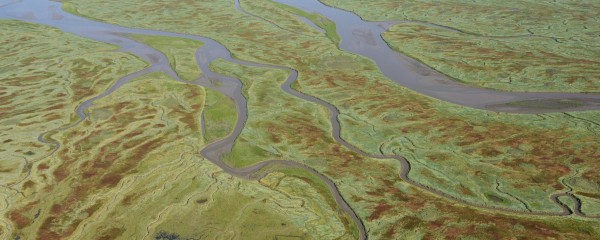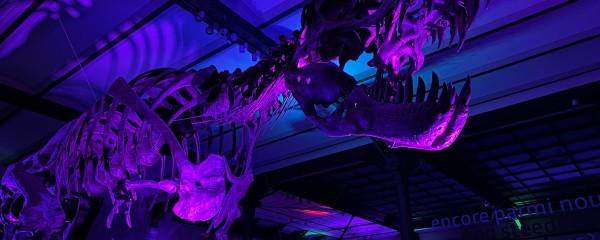Dust played a major role in dinosaur demise

Fine dust from pulverized rock generated by the Chicxulub impact likely played a dominant role in global climate cooling and the disruption of photosynthesis following the event.
This is suggested by a new study published in Nature Geoscience, in which researchers in Belgium, notably from the Royal Observatory of Belgium (ROB), the Vrije Universiteit Brussel (VUB), the Institute of Natural Sciences (RBINS) and the KU Leuven, contributed.
The Chicxulub meteorite impact has long been thought to have triggered a global impact winter, which led to the demise of the dinosaurs and around 75% of species on Earth at the Cretaceous-Palaeogene (K-Pg) boundary 66 million years ago. However, what effect the various types of debris ejected from the crater had on the climate is debated, and exactly what caused the mass extinction remains unclear.
Previous research has suggested that sulfur released during the impact and soot from post-impact wildfires constituted the main drivers of an impact winter, and not the ejection of silicate dust into the atmosphere. However, this hypothesis was based so far on a limited knowledge of the actual size properties of the dust particles.

The fine dust may have lingered in the atmosphere up to 15 years after the impact, causing a global cooling of the Earth's surface of up to 15 degrees Celsius.
Researcher Cem Berk Senel (Royal Observatory of Belgium)
To evaluate the roles of sulfur, soot, and silicate dust on the post-impact climate, Cem Berk Senel, Orkun Temel, and Özgür Karatekin, scientists from the Royal Observatory of Belgium (ROB), developed a new paleoclimate model, specialized to simulate the climate and biotic response following the Chicxulub impact. These simulations were carried out by incorporating new, high-resolution geological field data from a location in North Dakota, USA.
Sediment samples were collected and measured by means of laser-diffraction grain-size analysis by Pim Kaskes and colleagues at Archaeology, Environmental Changes & Geo-chemistry (AMGC) at the Vrije Universiteit Brussel (VUB) and the Vrije Universiteit Amsterdam (VUA). ‘We specifically sampled the uppermost millimeter-thin interval of the Cretaceous-Paleogene boundary layer. This interval revealed a very fine and uniform grain-size distribution, which we interpret to represent the final atmospheric fall-out of ultrafine dust related to the Chicxulub impact event. The new results show much finer grain-size values than previously used in climate models and this aspect had important consequences for our climate reconstructions,’ explains Kaskes.

Cem Berk Senel (ROB), the lead author, describes: ‘The new paleoclimate simulations show that such a plume of micrometric silicate dust could have remained in the atmosphere for up to 15 years after the event, contributing to global cooling of the Earth’s surface by as much as 15 °C in the initial aftermath of the impact.’
This timescale, according to co-authors Steven Goderis and Philippe Claeys (both VUB-AMGC), is consistent with the recent global iridium layer observations from the Chicxulub impact structure, where the final atmospheric settling of fine-grained impactor material in the dust cloud was estimated to be <20 years.
Furthermore, the authors find that dust-induced changes in solar irradiance may have shut down photosynthesis for almost two years post-impact. The prolonged disruption in photosynthesis constitutes a sufficiently long timescale to pose severe challenges for both terrestrial and marine habitats. Biotic groups that were not adapted to survive the dark, cold, and food-deprived conditions for almost two years would have experienced mass extinctions.
This matches the paleontological records, according to co-author Johan Vellekoop (KU Leuven and Institute of Natural Sciences), which show that fauna and flora that could enter a dormant phase (for example, through seeds, cysts, or hibernation in burrows) and were able to adapt to an omnivorous diet, not dependent on one particular food source (for example, deposit feeders), generally better survived the K-Pg event.

impact-generated ejecta (not to scale). (c) Paleoclimate model simulations showcasing the time evolution of the dust-induced
photosynthetic active radiation flux across the planet following the Chicxulub impact 66 million years ago
(modified from Senel et al., 2023; Nature Geoscience).
Fauna and flora that could enter a dormant phase and were able to adapt to an omnivorous diet generally better survived the Chixculub-event
Palaeontologist Johan Vellekoop (KU Leuven, Institute of Natural Sciences)
‘The Chicxulub-sized impacts by kilometer-sized asteroids causing mass extinction events are rare, however, small- and medium-sized asteroids in the range of 100 meters are far more common in the Solar System and can cause destruction on a regional to national scale,’ says Özgür Karatekin (ROB). The European Space Agency’s Hera asteroid mission for planetary defense is Europe’s contribution to an international planetary defense experiment to which authors of the present research from the Royal Observatory of Belgium and VUB are contributing. The Hera mission will validate the kinetic impactor asteroid deflection technique and provide scientific information, thereby increasing our understanding of asteroid geophysics and impact processes.

Article based on the press release of ROB and VUB.



